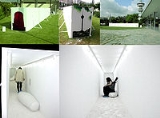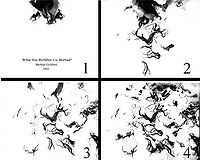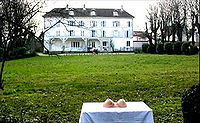
Barbad Golshiri
Encyclopedia

Tehran
Tehran , sometimes spelled Teheran, is the capital of Iran and Tehran Province. With an estimated population of 8,429,807; it is also Iran's largest urban area and city, one of the largest cities in Western Asia, and is the world's 19th largest city.In the 20th century, Tehran was subject to...
, Iran
Iran
Iran , officially the Islamic Republic of Iran , is a country in Southern and Western Asia. The name "Iran" has been in use natively since the Sassanian era and came into use internationally in 1935, before which the country was known to the Western world as Persia...
. His father was Houshang Golshiri
Houshang Golshiri
Houshang Golshiri was an Iranian fiction writer, critic and editor. He was one of the first Iranian writers to use modern literary techniques, and is recognized as one of the most influential writers of Persian prose of the twentieth century.-Early life:...
, a famous Iranian writer. He studied painting
Painting
Painting is the practice of applying paint, pigment, color or other medium to a surface . The application of the medium is commonly applied to the base with a brush but other objects can be used. In art, the term painting describes both the act and the result of the action. However, painting is...
at The School of Art and Architecture, Azad University
Islamic Azad University
Islamic Azad University is a private chain of universities in Iran.Headquartered in Tehran, Iran, the Islamic Azad University was founded in 1982 and currently has an enrollment of 1.5 million students, making it the world's third largest...
, Tehran. He has worked both as a media artist and a critic. He works with video, digital media, installation
Installation art
Installation art describes an artistic genre of three-dimensional works that are often site-specific and designed to transform the perception of a space. Generally, the term is applied to interior spaces, whereas exterior interventions are often called Land art; however, the boundaries between...
, photography
Photography
Photography is the art, science and practice of creating durable images by recording light or other electromagnetic radiation, either electronically by means of an image sensor or chemically by means of a light-sensitive material such as photographic film...
, the internet, graphic novel
Graphic novel
A graphic novel is a narrative work in which the story is conveyed to the reader using sequential art in either an experimental design or in a traditional comics format...
s and Lettrism
Lettrism
Lettrism is a French avant-garde movement, established in Paris in the mid-1940s by Romanian immigrant Isidore Isou. In a body of work totaling hundreds of volumes, Isou and the Lettrists have applied their theories to all areas of art and culture, most notably in poetry, film, painting and...
.
He won the third prize of the 6th Tehran Contemporary Painting Biennial, Tehran Museum of Contemporary Art
Tehran Museum of Contemporary Art
Tehran's Museum of Contemporary Art is an art museum in Tehran, Iran.Inaugurated in 1977, and built adjacent to Tehran's Laleh Park, the museum was designed by Iranian architect Kamran Diba, who employed elements from traditional Persian architecture. The building can be listed as a contemporary...
. In the criticism symposium of the biennial, Golshiri's paper was praised as one of the three best articles.
Most of his works are language-based and like other young Iranian artists he has severed his ties with the Iranian modern art movement. The exhibition "Iran.com: Iranian Art Today" in Freiburg's Museum für Neue Kunst (Museum for New Art) and the TREIBSAND DVD Magazine [Volume 01](Analyzing while Waiting (For Time To Pass); contemporary art from Tehran) focus on this generation.
Golshiri has portrayed himself as a critic of the current socio-political situation of Iran. In the Civil War series and in A Memorial for Potassium Suppository, shown in the first biennial of Thessaloniki, the artist attacked Chain murders of Iran
Chain murders of Iran
The Chain Murders of Iran , or Serial Murders, were a series of murders and disappearances from 1988-1998 by Iranian government operatives of Iranian dissident intellectuals who had been critical of the Islamic Republic system in some way.The victims included more than 80 writers, translators,...
. His father was one of the survivors of these murders.
Amiel Grumberg, the curator of "Too Much Pollution to Demonstrate: Soft Guerrillas in Tehran's Contemporary Art Scene - 2004" exhibition writes:
Barbad Golshiri's series of videos, installations, and photography expresses a remarkable balance between foreign art influences and Iranian resonances. Largely based on autobiographical experiences, his work echoes a general desire for change, but a change that excludes the possibility of losing any of the Iranian cultural heritage and way of life. Although the past has not been forgotten by the young generation, they refuse to accept the new rules established after the revolution. In his videopiece "What has befallen us, Barbad?" Golshiri transforms the obligation to cut his long hair before joining the army into a creative and intense moment. When used in neon-boxes, the video stills appear as arabesques, resembling calligraphy.

The title, What Has Befallen Us, Barbad?, is taken from a short story by this name written by Houshang Golshiri. In the story, Barbad is a five-year old boy who has witnessed what has been done to his father in the prison of Islamic Republic of Iran. Barbad stops talking and never describes what he has witnessed. Instead of talking, he draws childish but horrifying paintings. My name and my life are taken from this character. The short story itself has a hypotext. In Sassanid period, Khosrow Parviz (the Persian king) had a magnificent horse called Shabdiz. Parviz loved his horse frantically and had said that he will kill any one who brings the news of Shabdiz’s death. Shabdiz dies and no one dares to bring the news to the king. Barbad, The courtier musician, comes and plays so sadly that makes the King ask: “has Shabdiz died?” In my work, Barbad, who is the artist, is mourning what has befallen him and us in a traditional manner. On the other hand, What Has Befallen Us, Barbad? is about Art Praxis: is on my Faustian experience; Selling not just my soul, but also my body. That is why I chose Body Art and I chose myself as the subject of the Praxis. This piece is about exhausting myself with Art, but not for any rewards or exalted goals. It is just because of my addiction; because of the cancer of time: a poor habit. For nothing, if you prefer.
In Apex Art conference Abbas Milani
Abbas Milani
Abbas Malekzadeh Milani is an Iranian-American historian and author. Milani is a visiting professor of Political Science and the director of the Iranian Studies program at Stanford University. He is also a research fellow and co-director of the Iran Democracy Project at Stanford University's...
, The Iranian writer who lives in exile, gave a lecture on the video showing no interest in the Stereotyped issues. Milani said:
In mid-eighties, Houshang Golshiri wrote a short story of stunning power. It has much in common with his later masterpiece, King of the Benighted-a book I translated into English. In What Has Befallen Us, Barbad?, the narrator, a woman, talks of her son, named Barbad; a child who has seen the inferno of an Islamic Republic prison and the experience has rendered him mute. He only observes, and paints; the "horror, horror" of what he has seen can not be rendered in words. Only images can help assuage his anger and pain.
Not long after his father's death, his son, the Barbad of the story, and the eternal BarbadBarbadBarbad or Barbad the Jahromi was a Persian musician of the Sassanid era, who lived during the rule of Khosrau II, 590 to 628..- Etymology :...
of Iranian history, has given us another rendition of his sad tale. Barbad is the troubled muse of Iranian music; he is our tormented Dionysus; he was a master of mirth and melancholy; to Khosrow-Parviz, the ultimate king of Pre-Islamic Iran, he sang of sorrows and victories; when the king's favorite horse, Shabdiz, died, no one dared tell him of his loss. He had threatened to kill any bearer of such message. Barbad cleverly conveyed the bad news through a masterful composition, and when the king was imprisoned by his son--'incidentally a rarity in Iranian history where it is always the fathers that kill their sons-the grieved Barbad burned his musical instruments, and cut off his own playing fingers lest he be tempted to make music again.Our Barbad takes a different path. He surely gives of himself, but not to kill his art, but to create it. This time, it is the patriarchs who are killing their children and imprisoning their souls, and the sons, defiant and self-assured, angry but not despondent, ask again, What Has Befallen us, Barbad?
The video begins with an empty white space, a tabula rasaTabula rasaTabula rasa is the epistemological theory that individuals are born without built-in mental content and that their knowledge comes from experience and perception. Generally proponents of the tabula rasa thesis favour the "nurture" side of the nature versus nurture debate, when it comes to aspects...
, a canvas. Defiantly, and briskly, a head of hair, as much of Bob MarleyBob MarleyRobert Nesta "Bob" Marley, OM was a Jamaican singer-songwriter and musician. He was the rhythm guitarist and lead singer for the ska, rocksteady and reggae band Bob Marley & The Wailers...
as of Barbad, as likely of a woman as a man, appears. There is no face, but only the menace of a scissor, and a pair of hands, clad in white. Hair, we know, is a much contested part of human anatomy in Islamic societies. In man, and even more so in woman, it is a potential tool of the devil. In woman, the first now eminently liberal President of the Islamic Republic told us, it is charged with erotic electricity. It can ensnare the hapless men around it. In man, too, it can be a sign of frivolity. Morality police roam the cities searching for men with long hairs, and for women with any evident hair. And Barbad, reversing the Samson myth, where hair was a sign and guarantor of his power, has turned the hair into the ultimate metaphor for all that has happened to art and humanity in Iran. But this is no mere lament against oppression. It is also a call to action; an act of creation. Not just of his soul, but even of his body the androgynous figure of these powerful images is willing to give. There is in the gestures of the hand and the head, defiance, anger, and sacrifice. In Kubrick's memorable beginning of Full Metal Jacket, young marines are being shorn of their hair, and of their identity, so that the foul-mouthed sergeant can make of them a killing machine. Here however, the sheering is voluntary, and from it comes the redemption of art. The scissor at times comes close to cutting not just the hair, but the hand--making art in Iran can be a dangerous proposition. Guerrillas, even if soft, are the enemies of state. There is also moments of apparent resignation, where the head seems to want to escape the ordeal, but a force, mysterious but powerful, keeps it in its place.
And by the end of the process, as the hand at times angrily, other times with decided deliberation, throws away the hair, the once empty canvas has become an eerily and powerfully resonant image, full of characters--there stands a hint of a cloud, and here the apparition of Simorgh, the wise bird of Iranian mythology. It is painting by "hair-drip," it is, to borrow Nietzsche's words, creating art by blood. Read in the context of Iran, it is a cry against oppression, censorship and brutality; read in a global semiotics, it is a defiant manifesto for the necessity of creating art, of communicating with the world at any price. Barbad is at once Persian and global.


Selected exhibitions by Barbad Golshiri
2009 – Video installation, 'Exhibition; (A Twenty-One Thousand, Eight Hundred and Four Minute Unworsenable Aplastic), Goteborg's Konstmuseum, Sweden.2008-09 – 'Unveiled; New Art from the Middle East', Saatchi Gallery, London, UK.
2008-09 – Video installation, 'Medium Religion', ZKM (Center for Art and Media), curated by Boris Groys and Peter Weibel, Karlsruhe, Germany.
2008 – Performance, 'Camera Ardens; A Performance With the Blind and Those Who see', Bétonsalon, curated by Pulpart, Paris, France.
2008 – Video screening, 'bedün´ ə onvän´ / Untitled Series', part of 'Iran: New Voices', the Barbican Center, curated by Vali Mahlouji, London, UK.
2007 – Video installation (solo exhibition), 'Masturpiece(s)', Access Artist Run Center, curated bu Jeremy Owen Turner, Vancouver, Canada.
2007 – Installation, "The First Contemporary Art Biennial of Thessaloniki", curated by Syrago Tsiara and Areti Leopoulou, Archeological Museum of Thessaloniki, Greece.
– Video installation, "Bound By (Verbunden-Gebunden)", Curated by Claudia- Maria-Luenig, Basement gallery, Vienna, Austria.
– Video, DVD Magazin TREIBSAND [Volume 01]: "Analysing while Waiting (For Time To Pass); contemporary art from Tehran". Concept by Susann Wintsch & Parastou Forouhar, Azad art gallery, Tehran.
– Videos, "Open House with Open Studios", curated by Magnus af Petersens and Elin Strand Ruin, Iaspis, Stockholm, Sweden.
2006 - 2007 – Video installations and photos, "Undercurrents06 (An Exhibition and Lecture Program )", curated by Dariush Moaven-Doust, Goteborg's Konstmuseum, Sweden.
2006 – Video, "Iran.com: Iranian Art Today", curated by Nicoletta Torcelli and Isabel Herda, Museum für Neue Kunst, Freiburg, Germany.
– Video, "Ausserordentliche Zustande", curated by Reto Pulfer, Zustand, Berlin, Germany.
– Video, "The fifth Gyumri international biennial of contemporary art", curated by Arpine Tokmajian, Gyumri, Armenia.
– Virtual exhibition of some pieces of "Odyssey-i " project, curated by Jeremy Owen Turner, Roland Quagmire's virtual space.
2005 – Three pieces of “Odyssey-i ” project in “portrait” group exhibition, Khak gallery, Tehran.
– Video: “Too Much Pollution to Demonstrate: Soft Guerrillas in Tehran's Contemporary Art Scene”, curated by Amiel Grumberg, Apex Art, New York.
2004 – Video: “Video Zoom: Beams of Blue”, curated by Hamid Severi, Sala 1, Roma.
– Video: “Turning Points”, curated by Laleh Khorramian and Media Farzin, LeRoy Neiman Gallery, Columbia University School of the Arts, New York.
– Video installation (group exhibition): “The Incredulity of Saint Barbad” in “For Bam”, a multi media group exhibition on Bam earthquake, warehouse near The Iranian Artists Forum, Tehran.
– Video: “Beams of Blue”, curated by Hamid Severi, Apeejay Media Gallery, New Delhi.
External links
- http://www.saatchi-gallery.co.uk/artists/barbad_golshiri.htm
- http://www02.zkm.de/mediumreligion/index.php?option=com_content&view=article&id=74:barbad-golshiri&catid=34:kuenstlerliste&Itemid=53&lang=en
- The official website of Barbad Golshiri
- Barakat Foundation Conference on Iranian Contemporary Art in Oxford University
- Amiel Grumberg's text on "What Has Befallen Us, Barbad?"
- On "What Has Befallen Us, Barbad?"
- Official Curriculum Vitae of Barbad Golshiri
- The 6th Tehran Contemporary Painting Biennial, Tehran Contemporary Museum of Arts
See also
- Iranian modern and contemporary art

